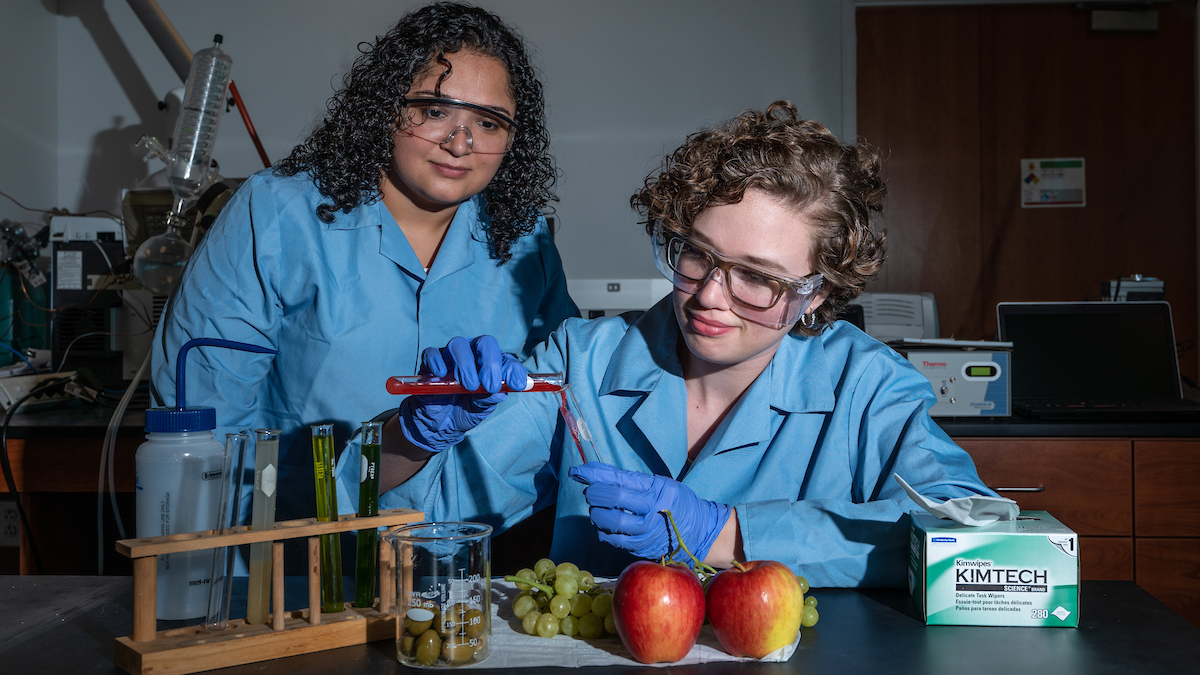Researchers Aim to Extract Therapeutic Compounds from Food

If an astronaut eats an apple aboard the International Space Station, where does the core go? On Earth, what happens to the waste generated by food processing?
Undergraduate researchers Katya Rivera and Allison Larsen, mentored by faculty member Dr. Foram Madiyar, are preparing to extract therapeutic compounds from food waste or “pomace” such as fruit peels, seeds and cores. If they can optimize the technique, it would dramatically reduce food waste and increase the healthy benefits of fresh fruits and vegetables – on Earth or in space.
Food pomace serves as a rich source of biologically active compounds (BACs) that offer key medicinal properties, said Rivera, an aerospace physiology major, along with Larsen. Currently, BACs turn up in foods and beverages as well as consumer products such as cosmetics.
“Biologically active compounds are antioxidants that can combat cardiovascular disease and hypertension, reduce inflammation and even inhibit tumor growth in certain instances,” Rivera said. “The research challenge is how best to extract the BACs and increase the yield without sacrificing beneficial biological properties. We want to identify the optimal conditions for efficiently extracting BACs from food pomace.”
The extraction technique, using ultra-high-pressure, could be scaled for industry settings, providing an environmentally friendly, cost-effective approach to decreasing food processing waste, Rivera added.
Based on principles of green chemistry, the research received support from the Office of Undergraduate Research as well as the College of Arts & Sciences. The project will get underway this summer, said Dr. Madiyar, assistant professor of physical science.
Tackling Food Waste
Some 20 percent to 30 percent of all food waste – between 0.3 and 0.5 billion tons of it – results from the processing of fruits and vegetables, according to the U.S. Food and Agriculture Organization. Managing this waste costs billions of dollars, Rivera said.
Yet, all of that food waste offers an opportunity to harness the economic and therapeutic potential of BACs, Dr. Madiyar explained. For example, grapes, tomato pomace, mango and tamarinds contain BACs called flavanols – antioxidants used as anti-cancer agents. Grape pomace, tomato peels, cucumber peels and citrus seeds offer another type of antioxidant called flavonones, which serve as cardio-protective agents and pain relievers. BACs also provide dietary fiber and essential fatty acids for good health.
The Embry-Riddle researchers will determine the ideal experimental pressure, temperature and other parameters for producing BACs most efficiently. Their goal is to optimize the overall process while achieving increased yield. “This would have large-scale implications when the process is scaled industrially,” Rivera noted.
First, the team will be compare food pomace obtained from industrial sources with pomace harvested at Embry-Riddle from olives, apples and grapes. Statistical modeling will be used to zero in on the most promising experimental parameters for BAC extraction. The Embry-Riddle researchers will do basic assessments such as physical and chemical characterization of the samples before they are shipped off to collaborators Siddharth Kesharwani and Sonali Pandey of South Dakota State University.
The food pomace will be placed inside an Ultra-High-Pressure Extraction machine to capture a cocktail of BACs. Analysis will involve a range of technologies designed to separate and identify different components of the samples. Technologies available to the Embry-Riddle team include, for example, various forms of spectroscopy (ultraviolet-visible, Fourier transform infrared, nuclear magnetic resonance, and mass spectroscopy) as well as gas chromatography.
Advanced Facilities and Curriculum
Soon after the project begins, Embry-Riddle’s Daytona Beach Campus will offer the first-ever organic chemistry class, beginning this fall. “Organic chemistry is a critical area of study,” Dr. Madiyar said. “It’s basically a dance of carbon, oxygen and nitrogen – elements that are the basis of life and commonly used in materials science and biology as well as chemical engineering.”
Much of the research will happen in the College of Arts & Sciences’ 600-square-foot chemistry laboratory, which includes two fume hoods, a gas chromatography instrument, various spectrometers, nuclear magnetic resonance imaging and more. Like the adjacent biology lab, the chemistry lab is set up to reinforce the importance of safety, Rivera said.
“As soon as class begins, the teacher discusses protocols for every possible type of emergency,” she added. “That helps us feel more confident before we even begin that first experiment.”
Rivera, a native of Ceiba, Puerto Rico, chose Embry-Riddle’s aerospace physiology program because she loves space, medicine, physics and chemistry. “I might want to be the kind of doctor that takes care of astronauts who have been in an extreme environment,” she said.
After she completes her undergraduate degree, Rivera hopes to pursue a Master’s and then a Ph.D. degree. “I like to study and educate myself,” she said. “I’m not exactly sure how my career will play out because I’m interested in so many different areas, but I’m getting great research experience in the meantime.”

 Ginger Pinholster
Ginger Pinholster